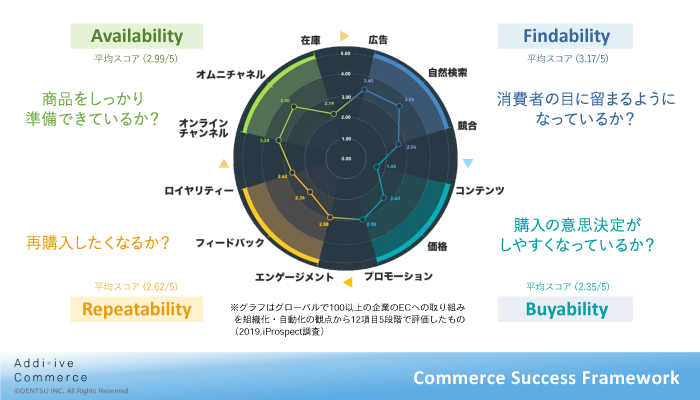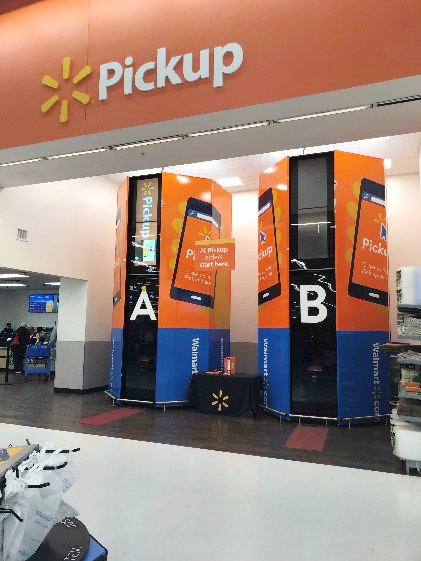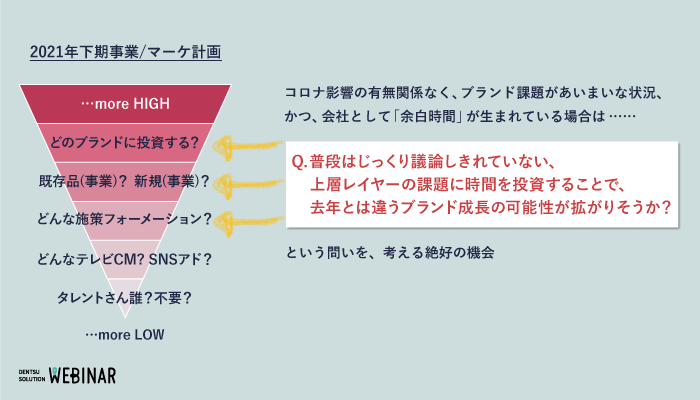Part 2 of the report on the "Dentsu Solution Webinar ~Part 1~" held on June 30. Following Part 1, this report covers the webinar content that introduced solutions for transforming on-corona/with-corona stay-at-home consumption into opportunities and addressing the next marketing challenges, all aimed at realizing a new normal style one step ahead.
Part 1: How Will Japan Change in the New Normal? Future Visions Derived from Consumer Research
"New Commerce Strategies Required in the With-Corona Era" (Dentsu Inc., Atsushi Nemoto)
First, he introduced the Dentsu Commerce Room, formed by gathering 16 Dentsu Group companies and establishing a 120-person team to solve clients' commerce challenges. He emphasized that the pandemic has necessitated rebuilding customer experiences—the point of contact at the supply chain's end—and that the key to solving this lies in the concept of adding new value by leveraging "a little extra effort from consumers." At Dentsu Inc. Commerce Room, this approach to creating customer experiences was named 'Additive Commerce.' Mr. Nemoto illustrated how Additive Commerce is emerging, using examples from physical retail, the food and beverage industry, and the e-commerce sector.

In drugstores, masks and disinfectants sold well, and stockpiling of paper goods occurred in late February. However, sales did not grow significantly during other periods due to factors like reduced demand for cosmetics. In contrast, supermarkets saw weekly sales consistently exceed the previous year's levels from late February onward. This was driven by "stockpiling behavior" for preserved foods like frozen and retort meals, as well as "increased household food spending" simply due to people spending more time at home. Furthermore, unlike drugstores, they explained that the number of items purchased per shopping trip and the average receipt value increased.
During the pandemic, not only did the types of items purchased change as described above, but shopping behavior also underwent significant shifts. It was pointed out that shopping behavior will continue to change in response to the "New Lifestyle" guidelines published by the Ministry of Health, Labour and Welfare. Subsequently, the presentation introduced the app of the major American supermarket Kroger, which allows shoppers to easily create shopping lists while viewing recommended products and coupon information. He explained that such apps are accelerating under the "New Lifestyle" framework. By leveraging the consumer's extra effort of "planning purchases," they create the benefit of shortening consumers' time spent in-store. For retailers, they offer the advantage of providing personalized promotions based on individual preferences and needs, along with point programs that seamlessly connect online and offline shopping.
Regarding changes in the food service industry hit hard by the pandemic, we noted the surge in takeout and delivery from April to May, highlighting the growing demand for mobile ordering services. Having customers place orders themselves enables contactless ordering and payment, shortening time spent in-store. The absence of cash handling also offers hygiene benefits for both consumers and staff. Furthermore, introducing mobile ordering allows businesses to capture customer information. It also serves as a communication tool for announcements should a second or third wave arrive, suggesting its adoption will grow among restaurants.
He also explained trends occurring in the e-commerce sector, where consumers are increasingly relying on online shopping for daily purchases, using the "Commerce Success Framework" developed by iProspect Japan, part of the Dentsu Group. EC operations were broken down into four key areas: "Availability" (whether products are reliably stocked), "Findability" (whether products are visible to consumers), "Buyability" (whether purchase decisions are made easily), and "Repeatability" (whether consumers are inclined to repurchase). The impact of the pandemic on these areas was analyzed, and the concept of Additive Commerce, which will be increasingly important going forward, was explained.

Availability is a particularly critical perspective during emergencies like the current one. While e-commerce gained significant traffic during the pandemic, many cases occurred where companies lacked sufficient network or server capacity to handle it, failing to meet consumer expectations. Others halted orders due to delivery delays. Furthermore, the entry and expansion of offline businesses into e-commerce has been significant, making omnichannel readiness an urgent priority for companies. However, the current situation is chaotic due to a shortage of personnel in both know-how and operations. As a solution to this situation, he suggested that the concept of Additive Commerce, which leverages consumers' voluntary actions, holds the key. Examples include introducing "BOPIS" (Buy Online, Pickup In-Store), where customers pick up items purchased on an e-commerce site at a physical store.

Pick up goods purchased on mobile
Walmart's Pickup Station
Regarding Findability, which assesses visibility to consumers, he pointed out that amid the pandemic chaos, resold goods flooded online platforms, becoming a significant challenge. To address this, he noted that alongside word-of-mouth monitoring tools, the need for e-commerce platform monitoring tools has increased, while the presence of official brand shops has also grown. It also noted that consumer use of social media increased during the pandemic, amplifying its role as a channel for companies to convey accurate brand information. Considering the launch of Facebook Shops in Japan, it stated that social media is an indispensable touchpoint with consumers for future e-commerce.
Next, regarding Buyability: whether purchasing decisions are becoming easier. In e-commerce, where customers cannot physically handle products like in a store, conveying product features through images is crucial alongside textual information. It is effective not only to ensure customers understand the product's size and functionality but also to show accessories and the packaging used for shipping. He noted that as contactless delivery—which relies on consumers taking an extra step to ensure safety—becomes more widespread due to the pandemic, the condition of packages upon arrival will become a key concern for consumers. He also highlighted the accelerating focus on interactive solutions, suggesting that live commerce, already leading in China and the US, will undoubtedly expand in Japan. He explained that featuring staff from physical stores allows the expertise gained from in-store customer service to be leveraged in e-commerce.
Furthermore, he defined "Repeatability" during the pandemic as recognizing customers' current situations and exploring feasible support methods, citing Hilton's extension of its points program until March 31, 2022, as an example. He also emphasized that as more physical stores enter e-commerce during the pandemic, integrating the shopping experience across online and offline channels to seamlessly encourage repeat purchases is crucial, with apps holding the key. He pointed out that promotional activities can now differentiate between online and offline channels, such as using online coupons during peak pandemic periods and store coupons during non-peak periods.

Finally, as Dentsu Commerce Room, we stated our commitment to creating safe, secure, and comfortable customer experiences through the Additive Commerce concept. By combining the following six solutions, we aim to rebuild consumer touchpoints and contribute to our clients' top-line growth.
① E-commerce consulting and operational support leveraging the Commerce Success Framework
② Business account solutions for maps, wallets, and SNS platforms that drive traffic from online channels
③ Robotic customer service and BOPIS solutions enabling contactless, non-face-to-face store interactions
④ Mobile ordering creating new dining experiences
⑤ Promotion CRM leveraging cashless payments to create OMO experiences integrating online and offline
⑥ Social commerce shifting purchases from "things" to "experiences"
White Paper: "What New Commerce Strategies Are Needed in the With-Corona Era?" Download URL:
https://www.d-sol.jp/dentsucommercereport/download/200630
"Solutions for the New Normal Era Created with Startups" (Takuma Kudo, Dentsu Inc.)
Mr. Kudo discussed how large corporations and startups can team up to create new marketing solutions, using his own work as an example.
While Kudo, with the title of Creative Strategist, has been involved in various communication planning including TV commercial production, a particular project led him to work in leveraging creative and branding techniques within new business development for large corporations and startup business development. Working in this environment, where creative production and new business development run parallel, he noticed something: Whether it's a large corporation or a startup, the means to grow one's brand are diversifying far beyond just mass media placements (often proposed by agencies), digital marketing, and PR. One such avenue is the marketing application for new ventures, which is the focus here.
He notes that from April to June, the content of meetings with CMOs and marketing directors changed significantly. Utilizing the extra time created by the pandemic, discussions moved beyond "how to proceed with current projects" to a higher level: conversations about "what investments to make in the first place" became much more common.
Mr. Kudo suggests that in today's rapidly changing environment, when teams can secure meeting time, they should dedicate it to topics not usually discussed in depth. For instance, investing time in higher-level issues like whether to grow the brand through existing businesses or new ventures, or what strategy formation to adopt. This creates an excellent opportunity to expand brand growth possibilities beyond existing initiatives.

He also explained the risks and significance of launching new initiatives during these challenging times, using the collaboration between the Tokyu Group and Userbase as an example.
Tokyu Plaza Ginza had been advancing a project since 2019 to create a physical space that transforms how business professionals learn and earn. While construction planning was already underway, the situation changed dramatically due to COVID-19. However, by discussing the project with a cross-functional team encompassing business, marketing, and CR/PR, they believed even this seemingly desperate crisis could be transformed into an opportunity for brand growth.
Amid the pandemic, project formation methods are also changing. There's an increasing trend of informal connections at the staff level via Facebook Messenger and similar platforms, leading to online brainstorming sessions.
Within this context, we explained our current approach: focusing on PR release output, clarifying roles among affiliated companies and departments, and exploring collaboration models when we sense potential for broader impact.
Economic media outlets, precisely because of these times, are reportedly seeking more positive economic news. I conveyed that this very moment presents an opportunity for our new project to be received as bright news for the Japanese economy.
Trendy buzzwords like D2C Inc. and CX often lead to thoughtlessness. Placing vaguely modern-sounding terms at the center of a project while neglecting the brand's customers is putting the cart before the horse. Whether it's COVID-19 or not, what matters in branding is "questioning the relationship between buyer and seller." Precisely because the pandemic era is filled with conflicting information and confusion, we want to return to basics and dedicate ourselves to solving our brand's customer challenges.
And in that context, if the idea leads to developing new ventures rather than investing in mass advertising or PR, I argued that there's never been a better time to take on such a challenge.











